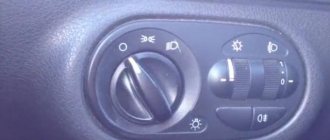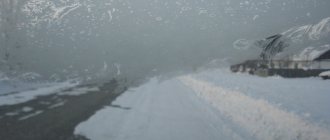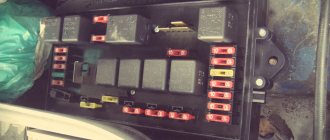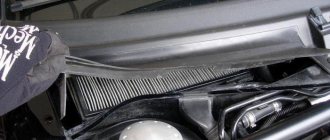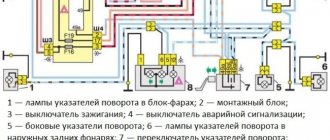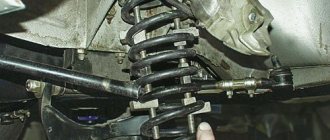Abnormal sounds coming from the chassis of a car are always unpleasant for any driver. There are many types of faults that cause this knocking noise. Often we are talking specifically about suspension elements, but sometimes these sounds are caused by completely different reasons. Each specific car model has its own design features, so atypical sounds coming from the front suspension can arise for very different reasons.
Functional load of Lada Largus suspensions
- Comfort during movement is achieved through the interaction of mechanisms focused on smoothness, muffling unevenness and eliminating unwanted vibrations.
- Handling is characterized by an adequate response to all steering commands from the driver. Moreover, accuracy and convenience of maneuvers become important aspects when increasing or switching speed.
- The suspensions of the Lada Largus contain actively moving parts, so the safety of the entire vehicle largely depends on them.
Front suspension
One of the main tasks of this element of the chassis is to ensure smooth movement. When the front wheel encounters an uneven road, the body continues its movement along the previously traversed trajectory, “damping” all vibrations.
Its design is much more complex than the rear variation, since it provides the ability to change the position of the front wheels, thereby providing effective control of movement in all directions. This is justified by a number of design features that are subject to additional loads.
It is worth noting that the front part of the Lada Largus, like any other car, is heavier than the rear, because the weighty units of the power and chassis are concentrated there. Undoubtedly, this causes a large load, which contributes to its rapid wear. Thus, the condition of the front suspension is directly related to the safety of driving the car.
Rear suspension
As a rule, the rear suspension of the Lada Largus is much simpler than the front: the wheels of the same name are not required to change the angle of rotation, and their orientation is focused only on vertical movement. But, despite this, the condition of this unit is also related to the safety of movement and the corresponding level of comfort.
In relation to it, semi-dependent and dependent varieties are considered. In the first case, the suspension consists of two levers fixed between the body and the wheels, which provides optimal kinematics. The dependent suspension is connected by a rear axle beam, which is attached to the body by trailing arms.
labavto.com
The suspension of the Lada Largus ensures comfortable movement. It is recognized by almost all motorists as unkillable. This is especially important on Russian roads. This detail is completely borrowed from Renault Logan. It is energy-intensive, soft and reliable. But problems arise with it from time to time. You can solve them without the help of others.
Design and properties of suspensions
The front suspension is an ordinary, comfortable and inexpensive MacPherson system, but with some modifications. It is mounted on a subframe. The front arms are attached to it. At the ends of the levers there is a ball joint, through which the lever is connected to the steering knuckle. Vibrations are dampened by shock absorber struts with coil springs. To avoid lateral tilts, a torsion stabilizer is installed.
If in old VAZ models the lever was changed separately from the ball joint, then on Largus the ball joints are changed immediately with the lower arm, as on Renault Logan. Largus also differs in that the stabilizer is secured to a lever located below. Thanks to the simplicity of the design and maintainability, you can find faults without the help of others at home.
The main part of the rear suspension is a semi-independent support, in the cavity of which there is a stabilizer, aggressively attached to the lower arms. The rear springs are attached to the lever with their lower end; its springs rest against the lever bracket through the gasket. The difference between the largus suspension is that the shock absorber and spring are separate parts that are not combined into a single unit. Any lever is attached to the body using silent blocks. The rear suspension is a reliable unit; it breaks occasionally, but it is easy to repair.
Diagnostics (the process of establishing a diagnosis, that is, a conclusion about the nature of the disease and the patient’s condition) and signs of suspension defects
One of the advantages of the Lada Largus is its reliable and long-lasting suspension. But despite this, over time the elements wear out. If you do the appropriate maintenance, identify and eliminate faults, you can extend the life of the suspension and prevent failure of its parts.
The subframe is the main element of the front suspension, therefore timely diagnosis (the process of establishing a diagnosis, that is, a conclusion about the nature of the disease and the patient’s condition)
This will allow you to avoid problems with the chassis and breakdown of the unit.
The levers, the rear part of the engine and the exhaust system pads are attached to it. Subframe faults must be found in the places where the suspension elements are attached. The corresponding symptoms (symptom is one separate specific complaint of the patient)
of the presence of defects are a knock in the front suspension, the destruction of wheel alignment changes.
To maintain a smooth ride, dampen road irregularities, ground clearance and smooth the machine while driving, shock absorber struts are installed. They limit body sway. The following signs indicate the presence of defects:
- The body sways when driving on uneven roads;
- oil smudges;
- knocking, vibration and creaking when moving;
- poor maneuverability;
- When hitting even small holes, impacts and jolts are felt.
When some of the coils of springs break off, the ground clearance is reduced, and the tilt of the body is noticeable if you install the machine on a flat surface.
The function of the anti-roll bar is to prevent the body from swaying and maintain the stability of the car on the road. Problems with a node are determined by the following symptoms:
- when driving on an uneven road, an iron knock occurs;
- if you brake sharply, the body sways a lot;
- On sharp turns there is a noticeable lean.
Using levers, the angle of rotation of the wheels is adjusted. Structurally, the lever is an iron pipe; thanks to a ball joint, it is connected to the steering knuckle. Problems are likely due to wear of the fixing silent blocks.
Malfunctions appear in the form of a knocking sound that occurs when the car hits a bulge, the drive wheels become unbalanced, the vehicle pulls in different directions while moving, and the steering wheel can be felt to move freely. If the hub wears out, the steering knuckles fail. You can find the fault by the uneven wear of the tire tread; when you turn the steering wheel, you can hear a creaking sound; the car pulls either to the right or to the left.
Diagnostics (the process of establishing a diagnosis, that is, a conclusion about the nature of the disease and the patient’s condition)
suspensions are carried out only on a flat plane. It makes it possible to find which parts and assemblies need to be changed. The suspension is checked in stages:
- First, we inspect the supports of the shock absorber struts. There should be a distance of no more than 1.5 cm between the glass and the top of the support.
- The steering wheel should simply rotate both to the left and to the right, with all this there should be no free play, no extraneous sounds in the form of crackling and squeaking.
- Check for free play by rocking balls, arms and rods from side to side.
- Try rocking the car. If the springs are in good condition, after a few vibrations the body will return to its previous position.
- Create a visual inspection of silent blocks. If any flaws are found, they need to be replaced.
Diagnostics (the process of establishing a diagnosis, that is, a conclusion about the nature of the disease and the patient’s condition)
front suspension.
Most of the suspension parts, excluding springs, cannot be repaired. If they are faulty, they need to be replaced with new parts.
Restoring the suspension
Suspension repair work includes dismantling and replacing worn and faulty parts.
To do this you will need to prepare the following tools:
- Screwdriver Set:
- a set of keys;
- set of heads;
- jack;
- hammer.
Replacing the anti-roll bar
To restore the performance of the stabilizer, it is necessary to replace worn parts, which is carried out using the following method:
- Place the car on a hill or hang the front part of it.
- First, we clean the screw from dirt.
- Next, unscrew the nuts that secure the stabilizer to the lever. To prevent the screw from turning when unscrewing the fasteners, it must be held back.
- After this, remove the bushing from below.
- Now we take out the screw, bushing and washer.
- Similarly, unscrew the 2nd bolt securing the stabilizer bar and arm.
- We install new ones instead of old ones.
- We assemble in the reverse order of disassembly.
Malfunctions and ways to eliminate them
During its operation, the suspension can cause not only all sorts of sounds in the form of knocks and squeaks, but also direct problems with the steering. If this part behaves suspiciously, it should be immediately fully diagnosed.
Noise and knocking while driving
The main reasons for the suspension failure of the Lada Largus are related to uneven roads. For example, a knocking sound in the front suspension of a Lada Largus begins after the car falls into a hole or hits a bump.
In addition, the inexperience of the car owner is not the last circumstance that leads to repair of the chassis. Having noticed a pothole belatedly, the brake pedal is pressed, which only increases the load several times and aggravates the situation.
The problem may be faulty shock absorbers, worn ball joints, loose fastening bolts, or lack of lubrication. If worn parts need to be replaced, this should be done immediately. When a malfunction of the suspension is associated with the fixing force or lack of lubricant, tightening them and appropriate lubrication will correct the situation.
If there is noise or knocking in the rear suspension, in addition to rubber seals and torque rods, attention should be paid to the condition of the exhaust pipe. A detailed analysis of the entire mechanism allows you to accurately determine the cause of the breakdown and eliminate it in a timely manner.
Departure of a vehicle from straight-line motion
Most often this is due to different tire pressures, incorrect wheel alignment or incorrect bearing clearance. These problems are resolved by checking and adjusting the characteristics to suit normal operation.
In some cases, even disassembling the suspension using specialized equipment is required. For example, if the front suspension arm of a Lada Largus is severely deformed, then the entire axle will need to be replaced.
It is worth noting that tire defects may not be immediately noticeable, so you should swap the wheels of the front of the car. If the direction of care changes, then the problem is in the condition of the rubber. When the loss of strength of one of the springs is to blame, it will immediately compress, affecting the visual tilt of the car body.
Vertical oscillation of the front wheels
This situation most often develops during braking or accelerating to maximum speed. The passenger car begins to tilt, and under the influence of road unevenness it makes oscillatory movements. This is justified by a possible imbalance of the wheels, settling of the suspension springs or failure of the shock absorbers.
In this case, the anti-roll bar may simply not work during acceleration and braking. Here you should check the condition of all parts and, if they are worn, replace them by securely tightening the fixing bolts.
Characteristics and design
The suspension on the Lada Largus has proven itself to be reliable, soft, energy-intensive and as simple as possible. Like many components, it migrated almost unchanged from Renault Logan. Manufacturers decided not to modernize this Logan part, which was recognized by car enthusiasts as indestructible on Russian roads.
Front suspension device
The main structural details are the following elements:
- stretcher;
- levers;
- spherical bearing;
- silent blocks;
- repeated fist;
- hub;
- shock absorber with spring;
- anti-roll bar.
Experienced car enthusiasts will immediately understand that structurally this is an ordinary MacPherson, but there are some dissimilar parts. Unlike other models of the Volzhsky Automobile Plant (with the exception of the Vesta family), the Lada Largus suspension is equipped with a subframe to which an anti-roll bar with silent blocks is attached.
The front suspension of the Largus is independent, and the subframe serves to increase rigidity.
Also, in previous AvtoVAZ models, the ball joint is changed separately from the lever. Largus uses the Logan suspension platform, so here the ball joints are changed only together with the lower arm. At the same time, we must pay tribute: the suspension design is reliable and durable.
The next difference between Largus is the mounting of the anti-roll bar. Here it is not rigidly attached to the strut with the shock absorber; it is attached directly to the lower arm. In this design there are no so-called tips, which are located on the rod connecting the strut and stabilizer. They usually wear out over time and become a source of suspension noise.
If you do not take into account the ball joint, which is assembled with the lower arm, the Largus front suspension is simple, and most importantly, repairable. Basically, problems begin to arise with fairly active mileage (more than 100,000 km). Due to the simplicity of the device and the small number of elements, even beginners can diagnose a fault.
Largus rear suspension diagram
Rear suspension features
The basis of the entire structure is a semi-independent beam. Inside it there is a stabilizer bar, which is rigidly fixed to the lower arms. The latter, in turn, (namely, the amplifiers) are supported by shock-absorbing springs.
The main feature of the Largus rear suspension is that the spring and shock absorber are not a single module, but are located separately from each other.
Structurally, the Largus rear suspension consists of a beam, shock absorbers, springs and silent blocks (not counting fasteners and other connecting elements). There are usually no special problems with the rear suspension, even with high mileage. The system, both front and rear, is reliable and easy to repair, and spare parts are always available.
Conclusion
Of course, detailed diagnostic procedures and timely elimination of the causes of the malfunction will allow you to quickly repair the suspension. In this matter, it is better to trust the specialists of service centers, who will help prevent major repairs by replacing some components or tightening the connections that secure them.
Car enthusiasts, and especially beginners, are afraid of any extraneous sounds when the car is working or moving. Often, when driving, an incomprehensible knocking sound from the front suspension may appear on small bumps at different speeds. Inexperienced motorists immediately go to a service station to solve problems, but specialists in most cases, after diagnosing the chassis, find nothing. But the knock remains, and something needs to be done about it. There is no need to rush to buy new parts for the chassis. It may well be that the reason for this knocking is a mere trifle, a trifle. Let's try to understand this issue, because the price of the front suspension is quite serious (repairs cost up to 500-1000 dollars), so it is so important to find the reason yourself.
And Largus also break down.
Time flew by imperceptibly. It seems like only yesterday that Largus was being tested and started in a high-speed 60-hour marathon, and now the number on the odometer has reached six figures. The character of the car is visible already in the first thousand, some aspects of operation appear a little later, and something concrete about reliability can only be said when the mileage is at least a hundred thousand km. This means it’s time to talk about Largus’ reliability.
LADA > Largus
Lada Largus
Year of issue
2012
In operation "Behind the wheel"
since August 2012
Mileage at the time of report
105,000 km
Publications in ZR:
2012, № 10; 2013, № 3, 8; 2014, № 3, 8; 2015, № 3, 8, 12; 2016, № 4, 8, 11
The most interesting mystery was thrown up by a failed thermostat. When driving along the highway, the engine began to cool down - this was noticeable both from the temperature sensor and from the cold air from the heater deflectors. The thermostat was changed. There wasn’t anything unusual in the nearby store, so we got an analogue from the Era company. The engine cooling system started working properly again, but quickly - after a few hundred km symptoms (Symptom from Greek - case, coincidence, sign - one separate sign, frequent manifestation of a disease, pathological condition or disruption of any vital process)
repeated. I really began to doubt that the reason was in the thermostat, but all the signs stubbornly pointed to its malfunction. In search of a good-quality thermostat, I scoured online forums, interviewed servicemen and sellers - and decided on a product from the famous Gates company. I hope I'm not mistaken. At least, the thermostat has been working flawlessly for 30,000 km.
By the eightieth thousand, the front suspension began to knock on the left. The reason was quickly found: significant free play arose in the ball joint. At the same time, the right one was fully functional, so they changed the support only on the driver’s side. This decision justified itself: the native ball is alive to this day.
An inspection on the lift revealed another malfunction: they asked to replace the stabilizer link. When the worn parts were removed, it was discovered that the mounting bolts were dangerously corroded. After some time they would break off - and the shoulders of the stabilizer would rest against the road, thereby immobilizing the car. And if it happened while moving... So the tragedy is not far away. At the same time, not only Largus suffer from this disease, but also other cars built on the B0 platform. Be carefull!
- By the hundredth thousand km the springs began to show the first signs of lethargy. They did not leak, did not make knocking noises during operation - the deterioration of features and the need for immediate replacement were evidenced by Largus’s behavior on the road, which was not as confident as before. The springs chosen for replacement were Excel-G series springs from the KYB brand, which turned out to be 10–15% cheaper than the unique ones. To get an extended warranty for them, we decided to contact Fit-Servis for work - this is one of the official partners of KYB.
Before the replacement, servicemen checked the suspension, steering control and braking system. The only criticism our Largus received was that the rear brakes were dirty. Indeed, it is time to cleanse them.
When replacing the shock absorbers, the list of necessary spare parts was also supplemented with a set of upper shock absorber strut supports.
Having looked at the rather long list of work performed and spare parts, I can’t call Largus completely problem-free. Although the car fully deserves the epithet “reliable”: it has never stopped on the road due to a malfunction, and unscheduled repairs were not so severe that it would be out of action forever. The advantages include low prices for spare parts and service, and good maintainability.
Recently, the cost of every kilometer traveled by our Largus has increased. The prerequisite was considerable expenses for suspension repairs, purchase of tires, and a battery. But now Largus is in good shape and is unlikely to require heavy investments in the near future.
Source: www.zr.ru
How to check silent blocks?
A flat mount will be required for diagnosis. This will allow you to determine how badly these parts are worn. Using the mount, the lever will move in the longitudinal and transverse directions. If there is play or damage, then the front suspension silent blocks are to blame for the knocking.
Sometimes the levers can be collapsible. Then you can replace it with a silent block. To do this, the lever is dismantled, and then, using a special mandrel, the part is squeezed out. It is advisable to lubricate the new silent block before installation. The seating surface must also be cleaned. After installation, the knocking should stop.
Steering
Even for experienced service engineers from numerous car repair shops, finding the cause of extraneous knocking noises is a serious problem. Many people immediately recommend replacing the shock absorber strut. Here it is, new, on the car, and the strange knocking noise in the front suspension on small bumps has not gone away. The car owner goes to another service center, but there they offer him to replace the support bearing, but even after that the knocking noise does not disappear.
When diagnosing the front suspension, experienced car owners begin checking with the steering system.
The main causes of vibration in the steering wheel
Among the popular reasons that cause a slight knock in the front suspension on small bumps is a large gap between the steering rack and gear. This is the result of wear and tear. To make an accurate diagnosis, it is recommended to pull the steering rods up and down. At the same time, carefully observe the movement of the rod. If she doesn't move, then she's fine. If the rod dangles, then most likely the bushings are worn out.
If the rack turns, then the accurate diagnosis is a large gap in the engagement. But this problem can be easily eliminated by tightening this very rail. Also, when pulling the steering rod, you may notice broken or overly worn bushings securing the steering rods to the steering rack.
Another possible cause of knocking is the steering joint. Testing this hypothesis with both hands will be quite difficult. You'll need a friend's help. The assistant must turn the steering wheel very quickly and sharply, and the car owner must grasp the hinge in such a way as to hold the hinge itself, its body and finger. If there is wear, you can feel the play. Then suspension repairs will not be necessary in the near future, and you will only have to buy and replace the hinge bushing.
Upper rack support
This can also cause knocking in the front suspension over small bumps. On car forums, the topic dedicated to this knock is very popular. The reasons are different for everyone. In attempts to combat this annoying sound, car owners go through the entire suspension, but often the knock remains.
One possible cause is the upper strut support. It consists of a rubber part as a damper and a bearing. If this rubber element has lost its elasticity, then this is the cause of this extraneous knock that all drivers struggle with. In order to find out for sure whether this is so, measure the gap between the limiter and the support. In most cars this is easy to do, but in some models this unit may be closed. If measurements show that the gap is more than 10 mm, then the support must be urgently replaced. However, this gap is not always uniform. When measuring, it is recommended to focus on the average figure. It is worth checking this support carefully: on many cars this sound appears only on one side.
see also
Comments 31
So these are ball ones. Both. They don't wobble too much, but there is some free movement. Despite the fact that I already changed the left one 2 years ago to Sasic (the mileage was 46 t.km).
This is naturally depressing. Of the 72.5 thousand kilometers, 90% are the Moscow Ring Road and Dmitrovskoe Highway. A 10 t.km. — these are absolutely the autobahns of Europe. I don’t piss on people who are lying down. I pass junctions on bridges in the most level places (I literally understand on which bridge/overpass at which junction in which place I need to cross)
In addition, they said that the box needed to be sorted out. The right drive is loose, in Logan garage they basically said the same thing. 16 thousand for work + spare parts later depending on the situation. There, at first the oil seal sweated, and later leaked, and when I changed the gears of the 5th gear, I also changed the oil seal. The car service was recommended to Largus Shop on Korovinskoye Highway. The master of the bit took out the drive with a crowbar, because he didn't get out. And there is a huge suspicion that it was he who broke something there. But an autopsy will tell. Maybe it's not him. The oil seal at 50 t.km should not just leak either.
Thanks for the answer. I’ll also go on Monday to demonstrate it (to the service), it’s too loud and annoying
So these are ball ones. Both. They don't wobble too much, but there is some free movement. Despite the fact that I already changed the left one 2 years ago to Sasic (the mileage was 46 t.km).
This is naturally depressing. Of the 72.5 thousand kilometers, 90% are the Moscow Ring Road and Dmitrovskoe Highway. A 10 t.km. — these are absolutely the autobahns of Europe. I don’t piss on people who are lying down. I pass junctions on bridges in the most level places (I literally understand on which bridge/overpass at which junction in which place I need to cross)
In addition, they said that the box needed to be sorted out. The right drive is loose, in Logan garage they basically said the same thing. 16 thousand for work + spare parts later depending on the situation. There, at first the oil seal sweated, and later leaked, and when I changed the gears of the 5th gear, I also changed the oil seal. The car service was recommended to Largus Shop on Korovinskoye Highway. The master of the bit took out the drive with a crowbar, because he didn't get out. And there is a huge suspicion that it was he who broke something there. But an autopsy will tell. Maybe it's not him. The oil seal at 50 t.km should not just leak either.
How much are balls today, well + -
On exist.ru Sasic costs 500 rubles. Renoshnaya (original) 800 rub. There are also for 300.
Long story short, the bolt on the protection came loose

